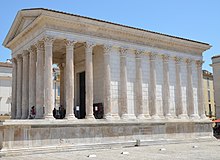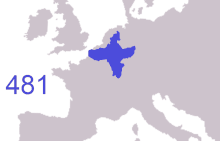France
During the Iron Age, what is now Metropolitan France was inhabited by the Gauls, a Celtic people. The Gauls were conquered by the Roman Empire in 51 BC, which held Gaul until 486. The Gallo-Romans faced raids and migration from the Germanic Franks, who dominated the region for hundreds of years, eventually creating the medieval Kingdom of France. France has been a major power in Europe since the Late Middle Ages, with its victory in the Hundred Years' War (1337 to 1453) strengthening French state-building and paving the way for a future centralized absolute monarchy. During the Renaissance, France experienced a vast cultural development and established the first steps of a worldwide colonial empire. The 16th century was dominated by religious civil wars between Catholics and Protestants (Huguenots).
Louis XIV made France the dominant cultural, political and military power in Europe, but in the late 18th century, the monarchy was overthrown in the French Revolution. One legacy of the revolution was the Declaration of the Rights of Man and of the Citizen, one of the world's earliest documents on human rights, which expresses the nation's ideals to this day. France was governed as one of history's earliest Republics until the Empire was declared by Napoleon, who dominated European affairs and had a long-lasting impact on Western culture. Following his defeat at the end of the Napoleonic Wars, France endured a tumultuous succession of governments: an absolute monarchy was restored, replaced in 1830 by a constitutional monarchy, then briefly by a Second Republic, and then by a Second Empire, until a more lasting French Third Republic was established in 1870.
France's colonial empire reached the height of global prominence during the 19th and early 20th centuries, when it possessed the second-largest colonial empire in the world.[7] In World War I, France was one of the main winners as part of the Triple Entente powers fighting against the Central Powers. France was also one of the Allied Powers in World War II, but it was occupied by the Axis Powers in 1940. Following liberation in 1944, a Fourth Republic was established and later dissolved in the course of the Algerian War. The Fifth Republic, led by Charles de Gaulle, came into being in 1958 and continues to operate today. In the era of decolonization, most of the French colonial empire became independent after the Second World War.
Throughout its long history, France has produced many influential artists, thinkers, and scientists, and remains a prominent global center of culture. It hosts the world's fourth-largest number of cultural UNESCO World Heritage Sites and receives around 83 million foreign tourists annually—the most of any country in the world.[8] France remains a great power with significant cultural, economic, military, and political influence in Europe and around the world.[9] It is a developed country with the world's fifth/sixth-largest economy by nominal GDP and tenth-largest by purchasing power parity.[10] In terms of total household wealth, France is the wealthiest nation in Europe and fourth in the world.[11] It also possesses the world's second-largest exclusive economic zone (EEZ), covering 11,035,000 square kilometres (4,261,000 sq mi).[12]
French citizens enjoy a high standard of living, and the country performs well in international rankings of education, health care, life expectancy, civil liberties, and human development.[13][14] France is a founding member of the United Nations, where it serves as one of the five permanent members of the UN Security Council. It is a member of numerous international institutions, including the Group of 7, North Atlantic Treaty Organization (NATO), Organisation for Economic Co-operation and Development (OECD), the World Trade Organization (WTO), and La Francophonie. France is a founding and leading member state of the European Union (EU).
History
Main article: History of France
Prehistory (Before the 6th century BC)
Main article: Prehistory of France
The oldest traces of human life in what is now France date from approximately 1.8 million years ago.[22] Humans were then confronted by a harsh and variable climate, marked by several glacial eras. Early homonids led a nomadic hunter-gatherer life.[22] France has a large number of decorated caves from the upper Paleolithic era, including one of the most famous and best preserved: Lascaux[22] (approximately 18,000 BC).At the end of the last glacial period (10,000 BC), the climate became milder;[22] from approximately 7,000 BC, this part of Western Europe entered the Neolithic era and its inhabitants became sedentary. After strong demographic and agricultural development between the 4th and 3rd millennia, metallurgy appeared at the end of the 3rd millennium, initially working gold, copper and bronze, and later iron.[23] France has numerous megalithic sites from the Neolithic period, including the exceptionally dense Carnac stones site (approximately 3,300 BC).
Antiquity (6th century BC-5th century AD)
In 600 BC, Ionian Greeks, originating from Phocaea, founded the colony of Massalia (present-day Marseille), on the shores of the Mediterranean Sea. This makes it France's oldest city.[24][25] At the same time, some Gallic Celtic tribes penetrated parts of the current territory of France, and this occupation spread to the rest of France between the 5th and 3rd century BC.[26]
The Maison Carrée was a temple of the Gallo-Roman city of Nemausus (present-day Nîmes) and is one of the best preserved vestiges of the Roman Empire.
Around 390 BC the Gallic chieftain Brennus and his troops made their way to Italy through the Alps, defeated the Romans in the Battle of the Allia, and besieged and ransomed Rome. The Gallic invasion left Rome weakened, and the Gauls continued to harass the region until 345 BC when they entered into a formal peace treaty with Rome. But the Romans and the Gauls would remain adversaries for the next several centuries, and the Gauls would continue to be a threat in Italia.
Around 125 BC, the south of Gaul was conquered by the Romans, who called this region Provincia Nostra ("Our Province"), which over time evolved into the name Provence in French.[27] Julius Caesar conquered the remainder of Gaul and overcame a revolt carried out by the Gallic chieftain Vercingetorix in 52 BC.[28] Gaul was divided by Augustus into Roman provinces.[29] Many cities were founded during the Gallo-Roman period, including Lugdunum (present-day Lyon), which is considered the capital of the Gauls.[29] These cities were built in traditional Roman style, with a forum, a theatre, a circus, an amphitheatre and thermal baths. The Gauls mixed with Roman settlers and eventually adopted Roman culture and Roman speech (Latin, from which the French language evolved). The Roman polytheism merged with the Gallic paganism into the same syncretism.
From the 250s to the 280s AD, Roman Gaul suffered a serious crisis with its fortified borders being attacked on several occasions by barbarians.[30] Nevertheless, the situation improved in the first half of the 4th century, which was a period of revival and prosperity for Roman Gaul.[31] In 312, the emperor Constantin I converted to Christianity. Subsequently, Christians, who had been persecuted until then, increased rapidly across the entire Roman Empire.[32] But, from the beginning of the 5th century, the Barbarian Invasions resumed,[33] and Germanic tribes, such as the Vandals, Suebi and Alans crossed the Rhine and settled in Gaul, Spain and other parts of the collapsing Roman Empire.[34]
Early Middle Ages (5th century-10th century)
See also: List of French monarchs and France in the Middle Ages
Frankish expansion from 481 to 843/870.
With Clovis' conversion to Catholicism in 498, the Frankish monarchy, elective and secular until then, became hereditary and of divine right.
The Franks embraced the Christian Gallo-Roman culture and ancient Gaul was eventually renamed Francia ("Land of the Franks"). The Germanic Franks adopted Romanic languages, except in northern Gaul where Roman settlements were less dense and where Germanic languages emerged. Clovis made Paris his capital and established the Merovingian dynasty, but his kingdom would not survive his death. The Franks treated land purely as a private possession and divided it among their heirs, so four kingdoms emerged from Clovis's: Paris, Orléans, Soissons, and Rheims. The last Merovingian kings lost power to their mayors of the palace (head of household). One mayor of the palace, Charles Martel, defeated an Islamic invasion of Gaul at the Battle of Tours (732) and earned respect and power within the Frankish kingdoms. His son, Pepin the Short, seized the crown of Francia from the weakened Merovingians and founded the Carolingian dynasty. Pepin's son, Charlemagne, reunited the Frankish kingdoms and built a vast empire across Western and Central Europe.
Proclaimed Holy Roman Emperor by Pope Leo III and thus establishing in earnest the French government's longtime historical association with the Catholic Church,[36] Charlemagne tried to revive the Western Roman Empire and its cultural grandeur. Charlemagne's son, Louis I (emperor 814–840), kept the empire united; however, this Carolingian Empire would not survive his death. In 843, under the Treaty of Verdun, the empire was divided between Louis' three sons, with East Francia going to Louis the German, Middle Francia to Lothair I, and West Francia to Charles the Bald. West Francia approximated the area occupied by, and was the precursor, to modern France.[37]
During the 9th and 10th centuries, continually threatened by Viking invasions, France became a very decentralised state: the nobility's titles and lands became hereditary, and the authority of the king became more religious than secular and thus was less effective and constantly challenged by powerful noblemen. Thus was established feudalism in France. Over time, some of the king's vassals would grow so powerful that they often posed a threat to the king. For example, after the Battle of Hastings in 1066, William the Conqueror added "King of England" to his titles, becoming both the vassal to (as Duke of Normandy) and the equal of (as king of England) the king of France, creating recurring tensions.






No comments:
Post a Comment